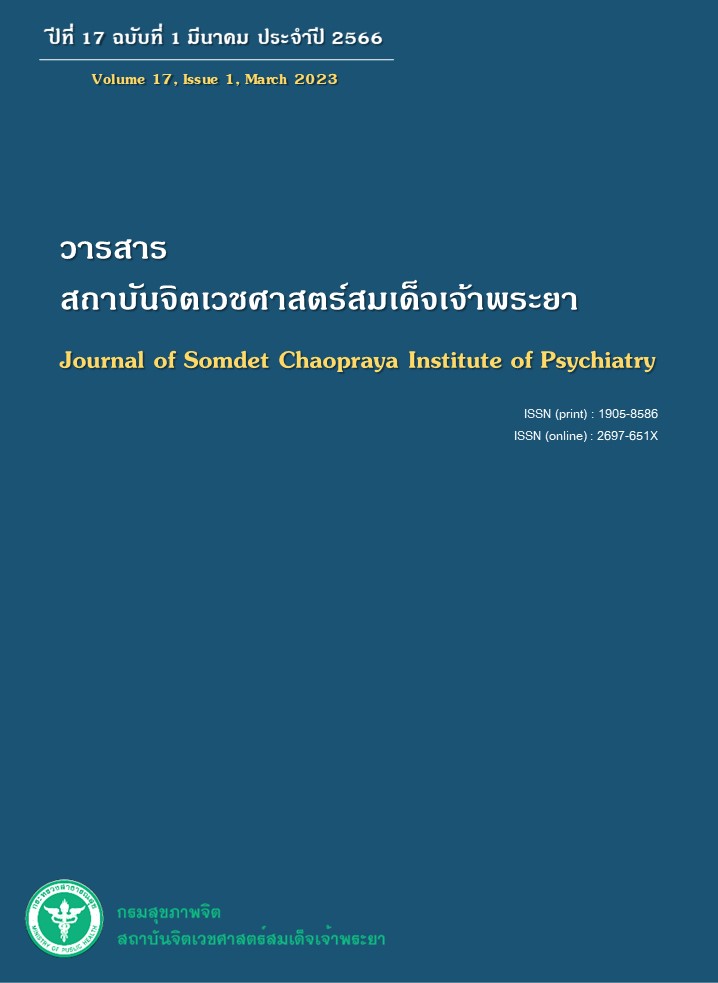ผลของการจัดกิจกรรมโยคะต่อสุขภาวะทางจิตและคุณภาพชีวิตในวัยรุ่นตอนต้น
คำสำคัญ:
คุณภาพชีวิต, โยคะ, วัยรุ่นตอนต้น, สุขภาวะทางจิตบทคัดย่อ
วัตถุประสงค์ : ศึกษาผลของการจัดกิจกรรมโยคะต่อสุขภาวะทางจิตและคุณภาพชีวิตในวัยรุ่นตอนต้น
วัสดุและวิธีการ : การวิจัยแบบกึ่งทดลอง สุ่มกลุ่มตัวอย่างจากนักเรียนชั้นมัธยมศึกษาตอนต้น โรงเรียนมัธยมศึกษาแห่งหนึ่งในเขตกรุงเทพมหานคร แบ่งเป็นกลุ่มทดลองและกลุ่มควบคุม โดยกลุ่มทดลองฝึกโยคะตามแนวโยคะสูตรและหฐโยคะในชั่วโมงกิจกรรมเสริมของโรงเรียน ฝึก 1 ครั้งต่อสัปดาห์อย่างต่อเนื่อง 8 ครั้ง กลุ่มควบคุมทำกิจกรรมอื่น ๆ ตามปกติและไม่ได้ฝึกโยคะตลอดช่วงการทดลอง ทั้ง 2 กลุ่มทำแบบสอบถามก่อนและหลังการทดลอง เครื่องมือที่ใช้ คือ แบบสอบถามสุขภาวะทางจิตและแบบสอบถามคุณภาพชีวิตไทยแบบรูปภาพ กลุ่มทดลองตอบแบบสอบถามความคิดเห็นต่อการฝึกโยคะเพิ่มเติม วิเคราะห์ข้อมูลด้วยสถิติแจกแจงความถี่ Wilcoxon Signed Ranks Test และ Mann-Whitney U Test กำหนัดนัยสำคัญทางสถิติที่ระดับ 0.05
ผล : กลุ่มตัวอย่างจำนวน 44 คน ช่วงอายุ 13-15 ปี ระหว่างการศึกษาพบกลุ่มตัวอย่างเข้าเกณฑ์คัดออกจำนวน 18 คน (ร้อยละ 40.9) เหลือกลุ่มตัวอย่างจำนวน 26 คน (กลุ่มละ 13 คน) พบกลุ่มทดลองมีคะแนนเฉลี่ยของการมีสัมพันธภาพที่ดีต่อผู้อื่น ความสามารถในการจัดการกับสถานการณ์ต่าง ๆ การยอมรับตนเอง การเป็นตัวของตัวเอง สุขภาวะทางจิตโดยรวมและคุณภาพชีวิตด้านร่างกายในช่วงก่อนและหลังการฝึกโยคะแตกต่างกันอย่างมีนัยสำคัญทางสถิติ (p = .037 , .031, .022, .006, .006 และ .011 ตามลำดับ) เปรียบเทียบคะแนนเฉลี่ยต่าง ๆ ระหว่างกลุ่มทดลองและกลุ่มควบคุมไม่พบความแตกต่างอย่างมีนัยสำคัญทางสถิติ ความคิดเห็นของกลุ่มทดลองต่อการฝึกโยคะ คือ มีประโยชน์ให้ร่างการแข็งแรง ลดอาการปวดตามร่างกาย อารมณ์สงบขึ้น มีสมาธิดีขึ้น ชอบการฝึกโยคะร่วมกับเพื่อน อยากให้มีความสนุก และฝึกได้ต่อเนื่อง
สรุป : การจัดกิจกรรมโยคะในวัยรุ่นตอนต้น มีผลดีต่อผู้ฝึกในด้านการมีสัมพันธภาพที่ดีต่อผู้อื่น มีความสามารถจัดการสถานการณ์ต่าง ๆ ได้ดีขึ้น มีการยอมรับตนเอง เป็นตัวของตัวเองและมีสุขภาวะทางจิตโดยรวมดีขึ้น รวมถึงส่งเสริมคุณภาพชีวิตด้านร่างกาย ควรจัดเป็นกิจกรรมกลุ่มและมีความสนุกเป็นแรงจูงใจและฝึกอย่างต่อเนื่อง
เอกสารอ้างอิง
Smetana JG, Campione-Barr n, Metzger A. Adolescent development in interpersonal and societal contexts. Annu Rev Psychol 2006; 57: 25584.
Hazen E, Schlozman S, Beresin E. Adolescent psychological development: A review. Pediatr Rev 2008; 29(5): 161-8.
Polanczyk GV, Salum GA, Sugaya LS, Caye A, Rohde LA. Annual research review: A meta-analysis of the worldwide prevalence of mental disorders in children and adolescents. J Child Psychol Psychiatry 2015; 56(3): 345-65.
Collishaw S. Annual research review: Secular trends in child and adolescent mental health. J Child Psychol Psychiatry 2015; 56(3): 370-93.
Sánchez-García A, Lucas-Molina B, Fonseca-Pedrero E, Pérez-Albéniz1 A, Paino M. Emotional and behavioral difficulties in adolescence: Relationship with emotional well-being, affect, and academic performance. An de Psicol 2018; 34(3): 482-9.
Ekasawin S, Phothisut C, Chomchuen R. The prevalence of psychiatric disorders in Thai students aged 13-17 year. J Ment Health Thai 2016; 24(3): 141-53.
Wang D, Hagins M. Perceived benefits of yoga among urban school students: a qualitative analysis. Evid Based Complement Alternat Med 2016; 2016: 8725654.
Nanthakumar C. The benefits of yoga in children. J Integr Med 2018; 16(1): 14-9.
Kwasky AN, Serowoky ML. Yoga to enhance self efficacy: an intervention for at-risk youth. Arch Psychiatr Nurs 2018; 32(1): 82-5.
Butzer B, LoRusso AM, Windsor R, Riley F, Frame K, Khalsa SBS, et al. A qualitative examination of yoga for middle school adolescents. Adv Sch Ment Health Promot 2017; 10(3): 195-219.
Butzer B, Day D, Potts A, Ryan C, Coulombe S, Davies B, et al. Effects of a classroom-based yoga intervention on cortisol and behavior in second- and third-grade students: a pilot study. J Evid Based Complementary Altern Med 2015; 20(1): 41-9.
Hagen I, Nayar U. Yoga for children and young people’s mental health and well-being: research review and reflections on the mental health potentials of yoga. Front Psychiatry 2014; 5: 1-6
Somsap Y, Lertpaiboon J. Health promoting experiences of female teenagers with yoga. JTNMC 2009; 24(4): 83-94.
Somsap Y, Kasetsomboon P, Krischareon S, Polain K. The effects of yoga on female adolescents’ health. Songkla Med J 2005; 23(3): 165-76.
Kaeomaungfang R. Effect of yoga training on stress reduction in primiparous pregnant teenagers [Master’s thesis]. Chonuri: Burapha university; 2017.
Gaspar T, Ribeiro JP, Matos MG, Leal I. Psychological well-being and health-related quality of life in children and adolescents: focus group methodology. J Clin Child Adolesc Psychol 2011; 4: 133-49.
Ryff CD, Keyes CL. The structure of psychological well-being revisited. J Pers Soc Psychol 1995; 69(4): 719-27.
Phattharayuttawat S, Ngamthipwatthana T, Pitiyawaranun B. The development of the Pictorial Thai Quality of Life. J Med Assoc Thail 2005; 88(11): 1605-18.
Danucalov MA, Kozasa EH, Afonso RF, Galduroz JC, Leite JR. Yoga and compassion meditation program improve quality of life and self-compassion in family caregivers of Alzheimer's disease patients: A randomized controlled trial. Geriatr Gerontol Int 2017; 17(1): 85-91.
Patikorn P. Psychological well-being, positive thinking, self-directed learning and prosocial behavior of undergraduate students in Kasetsart University [Master’s thesis]. Bangkok: Kasetsart University; 2011.
Suvarnarong K. The path of yoga: the science challenging Nurses’ role. J Nurs Sci 2014; 32(4): 15-24.
Gharote ML. Yogic Techniques. In: Kraivit W, Tangjitmeti J, translator, Bangkok: Folk Doctor Foundation; 2008.
Pannachet E. Yoga: Practical Guide. 2rd ed. Bangkok: Komolkemthong Foundation; 2000.
Kuvalayananda S, Vinekar SL. Yogic therapy: Its basic principles and methods. In: Kongpukdeepong K, translator. Bangkok: Folk Doctor Foundation; 2010.
Kraivit W. Yoga for human development. Bangkok: Thai Yoga Institute; 2005.
ดาวน์โหลด
เผยแพร่แล้ว
รูปแบบการอ้างอิง
ฉบับ
ประเภทบทความ
สัญญาอนุญาต
ลิขสิทธิ์ (c) 2023 วารสารสถาบันจิตเวชศาสตร์สมเด็จเจ้าพระยา

อนุญาตภายใต้เงื่อนไข Creative Commons Attribution-NonCommercial-NoDerivatives 4.0 International License.
บทความที่ได้รับการตีพิมพ์เป็นลิขสิทธิ์ของวารสารสถาบันจิตเวชศาสตร์สมเด็จเจ้าพระยา



